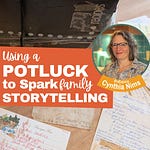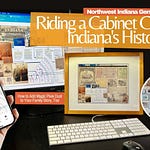If you participated in our live program, I hope you enjoyed it and the conversation with other members and participants. It’s an example of the kinds of programs we host here at Projectkin. We publish these “Recipe” projects to help you get your stories told — without the heavy lift of figuring out how to do it first. You can explore the full series of Project Recipes here:
Background: Connecting Through Time
Every family has deep roots. You are lucky if you know where those roots reach. On my maternal side, I have ancestors to thank for records that already take our story deep into the British colonial period in America. Our story is messy. There were difficult decisions, loved ones lost to disease, migrations, and wars. We were lucky. Enough survived so that we can be here to tell their stories.
Since I can lean on the records my ancestors collected, I focus my time on rounding out the stories that connect individuals to the historical and social context of their time.
In my journey, I was smitten by the slightest connection to Gilbert du Motier, the Marquis de Lafayette (1757-1834). It was a brush with a celebrity. This young aristocrat managed to play key roles in both the American Revolutionary War and the French Revolution. As if that weren’t enough, he returned to America a generation later as the “Nation’s Guest.” From August 1824 to September 1825, he ventured on a 13-month journey to all 24 states of the new nation.
That sent me down a “fur-lined rabbit hole.”
I knew I had ancestors in the Continental Army who might have known him during the Revolutionary War. Their children and grandchildren would have heard the war stories. Now, on his geezer tour, it’s pretty likely families would have tried to see him in person and listen to him speak.
His tour was packed with fabulous extravaganzas in nearly every town he visited. Programs included special events for veterans, highlighting the great battles at Brandywine, Bunker Hill, and Yorktown. You can see the fascination with his visit in the mass-produce giveaways, trinkets, and mementos that flooded the market. Many of these artifacts were prized as heirlooms.1

Getting Specific About Time
This national story inspired me to build an interactive timeline of Lafayette’s “Farewell Tour.” I wanted such a timeline to help me answer whether my ancestors might have met the Marquis de Lafayette.
Given the event's historic nature, I soon realized that the timeline could be repurposed by other families to explore their connection to the Marquis. Further, the same tool could be modified and applied to any other landmark event that affecting a community. This recipe describes that project & solution.
The Key Ingredient: Data
I was fortunate to receive the gracious support of the American Friends of Lafayette (AFL), an organization formed in 1932 by enthusiastic admirers of the Marquis. Using their thoroughly researched event timeline as a reliable data source, I could correlate my timeline to their published map of the towns along the Marquis’ route.

The Solution: An Interactive Timeline
The approach I used started with a Javascript timeline tool created for journalists by the Knight Lab at Northwestern University. The tool, originally developed for journalists, creates an elegant and interactive way to contextualize a journey with graphics and backgrounders. It starts with a preconfigured worksheet using Google Sheets to produce a timeline in a new link on the knightlab.com domain. The long URL generated from the tool can be unwieldy, so I created an easy-to-remember redirect on the Projectkin.org domain:
This post, “1824-25 Bicentennial: Did Your Ancestors Meet the Marquis de Lafayette?” written in November 2024, proposed the original design for the project but I needed a reliable source of historical data.

That initial post allowed me to demonstrate the idea and gain the support of the American Friends of Lafayette. With their help, I was able to make two important modifications to my original plan:
I now had a reliable timeline of events to work from supported by the historians at the ALF.
For maps of the journey, I could defer to AFL’s own at Lafayette200.org.
Inviting Community Participation
To make this effort even more interesting as a community project, I grouped stories from different community members into “event ribbons” along the bottom. All items contributed by members of our community are also color-coded with this dusty green (defined by the hex color, #8EA085).
The first ribbon, labeled “Lafayette Party,” includes events in his journey. The second, labeled “Community Connection,” includes moments when community members’ ancestors might have met the Marquis. Imagine members of a lineage or historical society viewing how their ancestors might have been connected through their participation in programs celebrating Lafayette, the “Nation’s Guest.”

Rephrasing the Problem into an Extensible Solution
I soon realized that the same formula could be applied to any sequence of fast-moving historical events. This means that lineage, historical societies, and a range of community groups connected by a common history can collaborate on a shared timeline. Once established, their narratives can be placed in the same historical context.
The same basic formula could be applied to any historical event. Examples that spring to mind include the English Civil Wars of the 17th century, the colonial period leading up to the American Revolution in the 18th century, and the collapse of the Qing Dynasty in the 19th century. The primary benefit of this timeline approach was the potential for many others to gain from a single investment of time in building the framework.
The open-source nature of the tool I used from the Knight Lab means that different groups can continue to improve on it and share their documentation quickly. Further, since the event-specific detail is compiled in a Google Sheet, no technical expertise is needed to customize it for your community — or a different historical event.
This post complements the recorded presentation and gives you direct access to the tools I used. You can also start from here to create a variation of your own.
Using The Timeline in Your Community
You can use this kind of timeline in your community in many ways. For example, you might…
Add it to your website as a call to action.
Share it with subscribers or members in a newsletter.
Use it as a bonding exercise for a group with a shared connection to the period captured in the timeline.
I was motivated to explore this timeline from a personal fascination with the story. The bicentennial of Lafayette’s 1824-1825 American Tour made it timely. My connection to the nearby town of Lafayette, California, made it a local story, too.
On hearing about the project, my Acalanes DAR chapter invited me to share the timeline as part of their celebrations in the Lafayette Library with a lecture, wreath-laying ceremony, and exhibit. I’m proud to have this opportunity to share this timeline and explore the method of sharing stories.
Interested in leveraging this story for your community group — or one you know of? Let me know! I’d love to help.
At Projectkin, we’re all about sharing storytelling forms suitable for family history. As is often the case, implementing a form can involve technical components and be intimidating. To dispel that, I boil the form into the tactical steps necessary to reproduce it, or simply “Project Recipes.”
Generally, our members present their project recipes in live events where we gather to discuss and encourage each other. To see past events and explore our recipes, please see Projectkin.org/recipes.
This recording captured a live event in which I presented this recipe to our members so that they could ask questions. The resulting project recipe and the slides used for this Lafayette Project presentation are below:
Project Recipe
Slides
Acknowledgments
I would not have been able to pursue this project without the unwavering support of my sisters in the Acalanes Chapter of the DAR. Particularly the encouragement of our fantastic genealogist, Vanessa Crews, and the unbending support of our remarkable chapter regent, Terry Lucido.
When I introduced the idea, Terry immediately saw the potential for our celebration of Lafayette’s story for our local community in Lafayette, California. She put me in touch with the American Friends of Lafayette (AFL), who are already partnering with the Daughters of the American Revolution (DAR) in this national celebration. Their tools and resources have been indispensable to telling this story.
Finally, I’m deeply grateful for the potential Patti McLay saw in this project. As National Chair of the DAR’s Franco-American Memorial Committee, she gave me access to the hard work of academics who’ve been telling Lafayette’s extraordinary story for generations.
I was honored to have this timeline be a part of our program celebrating the contributions of the Marquis in our town of Lafayette, California (map). Learn more about what we’re up to at Projectkin.org/lafayette.
Sadly, I’m not aware of any in my family, although they may be in the collections of my extended cousins. I look forward to seeing them in museum collections.














